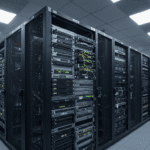We live in a connected world, no one disputes that. Connectivity and the onramps to that connectivity are constantly evolving. I can get on the Web with my MacBook (and a wired, wireless or cell connection), my Netbook (wired or wireless), my iPhone and my Blackberry (OK, not very often). The Internet also reaches out to me even when I’m not directly connected with email (way too often) and SMS (and other push services) from Facebook, Twitter, FourSquare, etc. As far as social interaction I use the Internet in a variety of ways and on a daily (hourly or more, really) basis. For business I couldn’t imagine working without it; I do research, communicate, collaborate, publish, and broadcast.
Connectivity though, ends at the person today, but the technology to extend that connectivity is converging at a rapid pace. The consumer scenario that “futurists” have used to explain the concept is the idea that your refrigerator could monitor food levels, shelf life, etc. and reorder for you when you need it and based on pre-defined parameters. There are really three keys, context awareness, mobile and embedded, that enable the scenario.
From an enterprise perspective these ideas of extending …
We live in a connected world, no one disputes that. Connectivity and the onramps to that connectivity are constantly evolving. I can get on the Web with my MacBook (and a wired, wireless or cell connection), my Netbook (wired or wireless), my iPhone and my Blackberry (OK, not very often). The Internet also reaches out to me even when I’m not directly connected with email (way too often) and SMS (and other push services) from Facebook, Twitter, FourSquare, etc. As far as social interaction I use the Internet in a variety of ways and on a daily (hourly or more, really) basis. For business I couldn’t imagine working without it; I do research, communicate, collaborate, publish, and broadcast.
Connectivity though, ends at the person today, but the technology to extend that connectivity is converging at a rapid pace. The consumer scenario that “futurists” have used to explain the concept is the idea that your refrigerator could monitor food levels, shelf life, etc. and reorder for you when you need it and based on pre-defined parameters. There are really three keys, context awareness, mobile and embedded, that enable the scenario.
From an enterprise perspective these ideas of extending the Internet out of its boundaries and connecting other devices (or making other devices “aware”, “smart” and connected) could be very powerful. In an announcement this week, Fedex provided an excellent example of this concept. In its new Senseaware service, which is in beta for this next year, Fedex embeds a sensor in shipments that combines cellular, thermometer, accelerometer, GPS and photosensor. Critical or perishable shipments can report parameters to the Internet that clients can then review and make actionable. For example, if a perishable medical shipment had a reduced shelf life in transit due to higher than normal temperature exposure, the shipment could be re-routed to a closer facility where it could be used before it expired. The package can report environmental conditions, location, whether it is dropped, opened, damaged, etc., in effect becoming a “smart” package. Here’s a pic of the device:
Add to the ability of creating smart devices an enterprise trend-of-event-driven architecture in software systems and the next step would naturally be deploying systems that could interact with all sorts of smart devices and even take actions without human intervention. In the supply chain there are certainly many good opportunities to utilize these devices but it would likely extend all over the enterprise.





